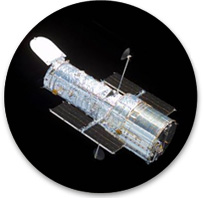
Next Generation Spectral Library
Using the Hubble Space Telescope Imaging Spectrograph (STIS), we have
begun collecting a library of stellar spectra for use in synthesizing
galaxy spectra.
In Cycles 10 and 12, the project was awarded 300 and
450 snapshots to obtain spectra of bright stars. The spectra cover the
wavelength range 1660Å to 10200Å using the low dispersion
gratings of STIS: G230LB, G430L, and G750L.
The goal is to amass a
library of 600 stellar spectra covering all temperatures and
luminosities, with roughly 150 stars in each of four metallicity
ranges:
-2.0 < [Fe/H] < -1.5
-1.3 < [Fe/H] < -0.5
-0.3 < [Fe/H] < +0.1
and
[Fe/H] > +0.2.
Observations began in September of 2001, during Cycle 10 of HST and
more data are being taken in Cycle 12.
There are now about 250 stars and counting, mainly in the solar
abundance and most metal poor samples because these were targeted
exclusively in Cycle 10. As more data come in during Cycle 12, more
stars in the other groups will be observed.
This will be the most comprehensive empirical stellar spectral
library ever produced.
We have proposed to continue the program in Cycle 13. Another
allotment of 450 snapshots would complete the bulk of data collection.
We also plan to augment the library with appropriate spectra from the
HST archive.
Here is a color-magnitude diagram showing
the distribution in the V-I vs. Mv plane of approximately 250 stars
observed as of January, 2004 (circled) and additional targets not yet
observed (dots) in each of the four metallicity groups.
This plot compares the spectra of two
early K giants, one solar abundance, the other having [Fe/H]=-1.8.
The difference in line blanketing, especially in the ultraviolet, is
great, underscoring the need for a multi-abundance library to perform
realistic spectral modeling of galaxies where a spread in abundance is present.
Although we are making
the preliminary reduced spectra available, they have two shortcomings,
which we are intent on addressing in the immediate future:
1) The first is an improved calibration for the E1 aperture where all
of our data were taken (E1 is near the end of slit, and the edge of
the CCD, a location which minimizes charge transfer losses). During
Cycle 11, standard star calibration data were taken at E1 and this
new, improved flux calibration should be made available by STScI real
soon now, we hope. Our reduction procedure includes a step which we
believe removes much of any difference between E1 and the central STIS
slit flux calibration, but once the official calibration is available,
we will begin using it.
2) In the G230LB mode, covering 1670Å to 2900Å, STIS has a
problem with red scattered light, much the same as the now-retired
Faint Object Spectrograph (FOS). The STIS CCD is very sensitive to
these red photons, and the scattered light contamination is
particularly significant for the reddest stars. While simple fixes
take care of the problem at the 50% to 90% level, this is hardly
better than zero-ing out the fluxes shortward of 2000Å for the
reddest stars. We are working on an empirical model to better remove
the scattered light.
A final caveat is that we are as yet making no correction for reddening.
Most of the stars are relatively nearby and so have small reddenings,
but this is an issue which will be addressed in detail as the library
develops and after we overcome the above two limitations.
Data Availability
We are close to an initial release of data, but there are still
some technical problems being sorted out, mainly with flux calibration
issues, especially
shortward of 2000Å and how best to splice the different gratings together.
We also hope to
get community feedback on the distribution format and web pages.
Watch this space for updates. Here is a
table listing the Cycle 10 observed targets.
Information about available spectra and download formats can be
obtained here .
Extension to Other Wavelengths and Resolutions
Observations using the SpeX instrument at the
Infrared Telescope Facility are being used to extend the spectra to
2.5µ m, at comparable resolution to STIS.
We also have a program to obtain high signal-to-noise, echelle
resolution spectra of the program stars using UVES on the ESO VLT.
Both the IR and echelle data will be added to the library in time.
The echelle data will be used to check and correct the atmospheric
parameters of the stars so that eventually they will all be on the same,
consistent system.
Another goal is to extend the library into the far-UV using
STIS archival data.
Using the STIS library as a basis, our ultimate intent is to devise
interpolation schemes to extract semi-empirical spectra of arbitrary
atmospheric parameters. To do this in a robust fashion, we will need
at least 600 stars to adequately cover abundance-luminosity-color space.
Last modified February, 2004
Please report any problems or comments to:
gregg@igpp.ucllnl.org
